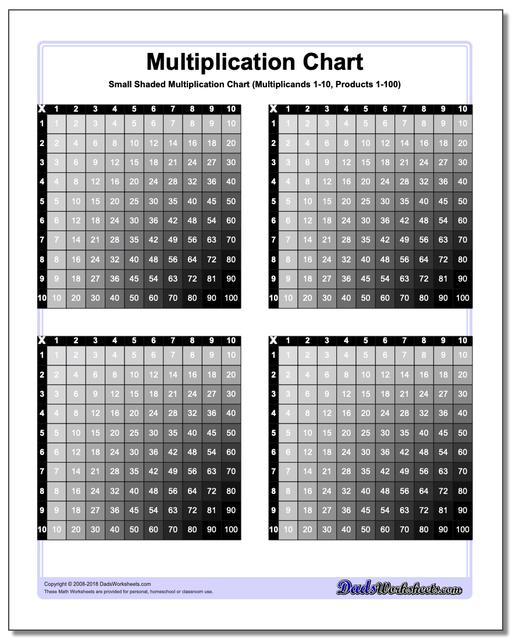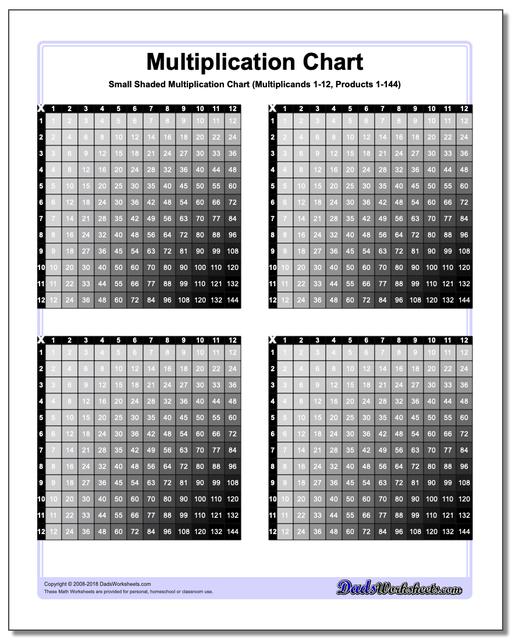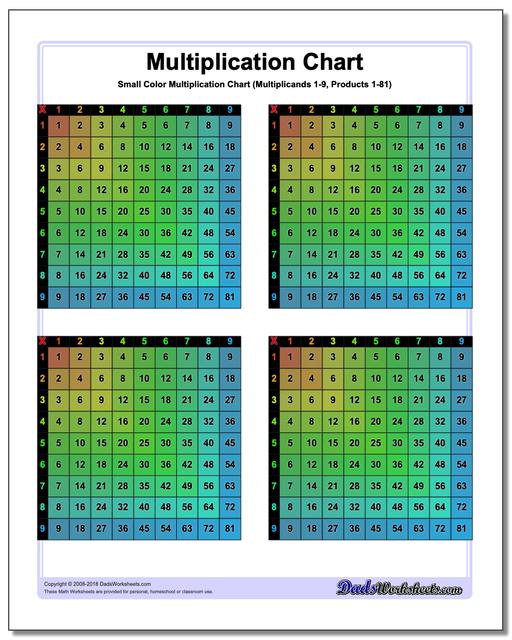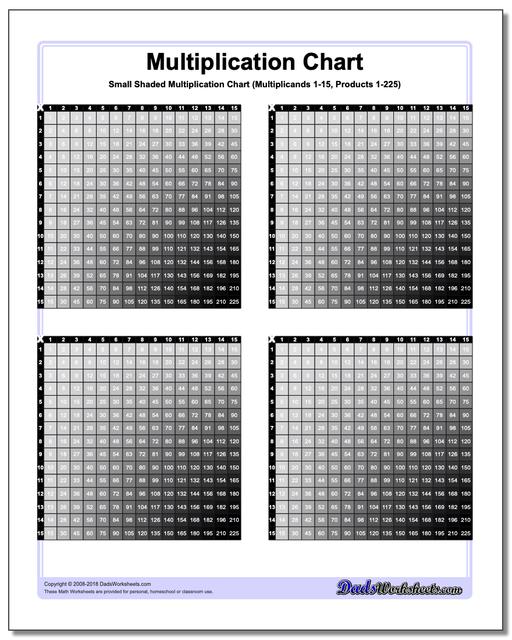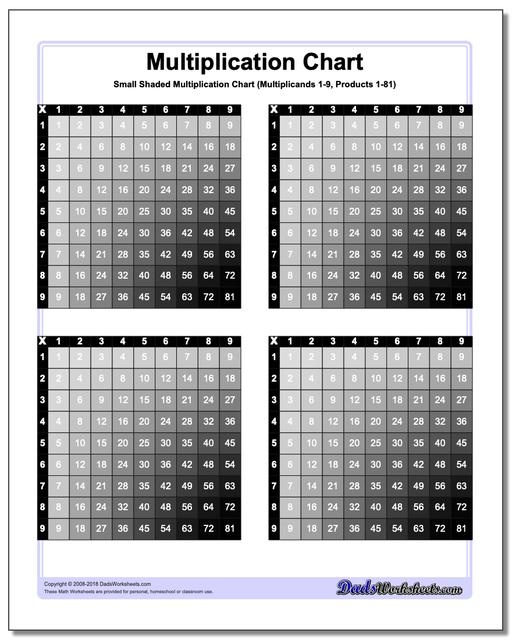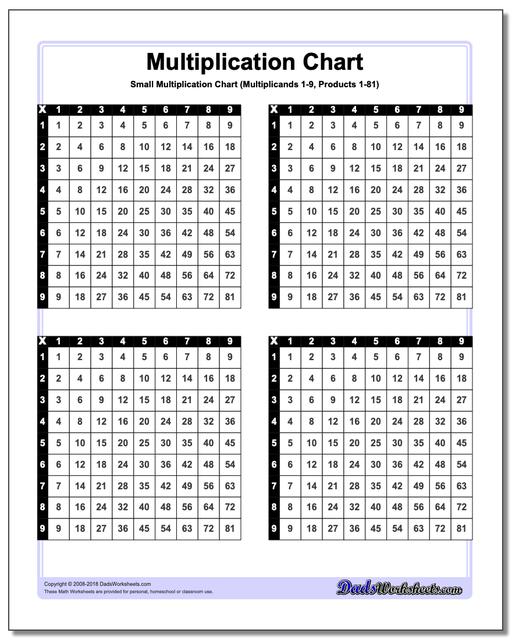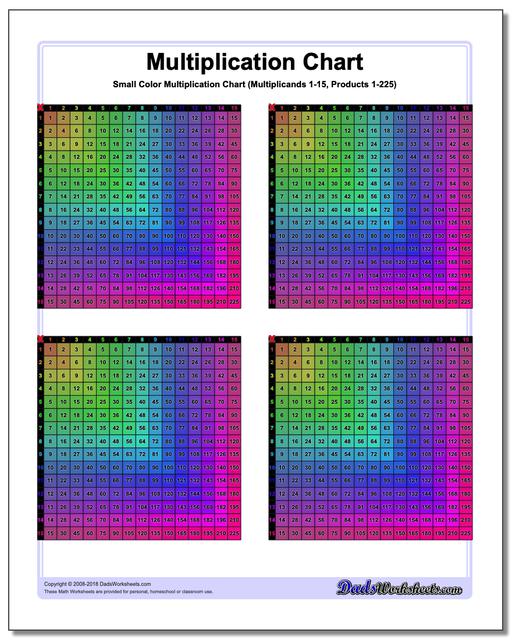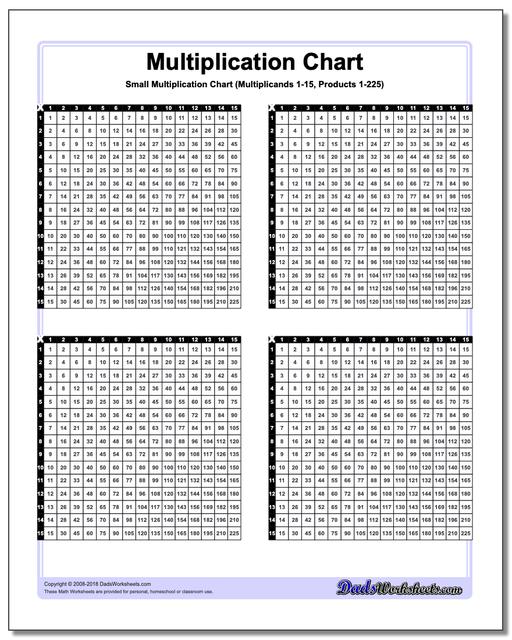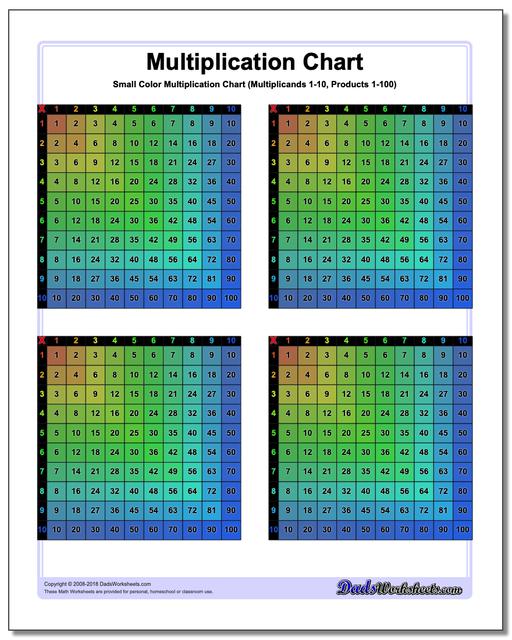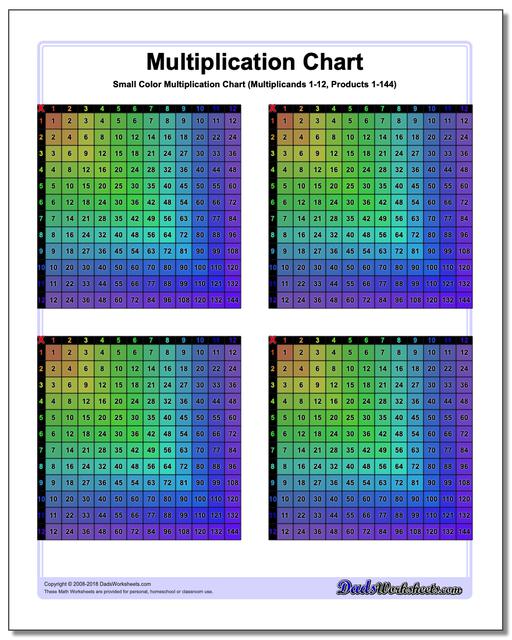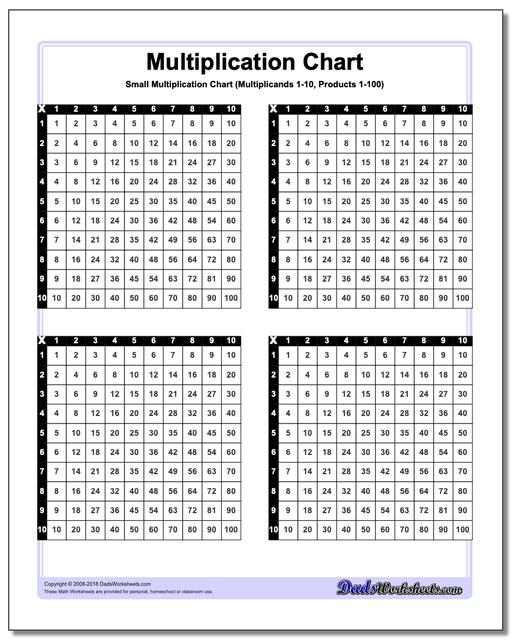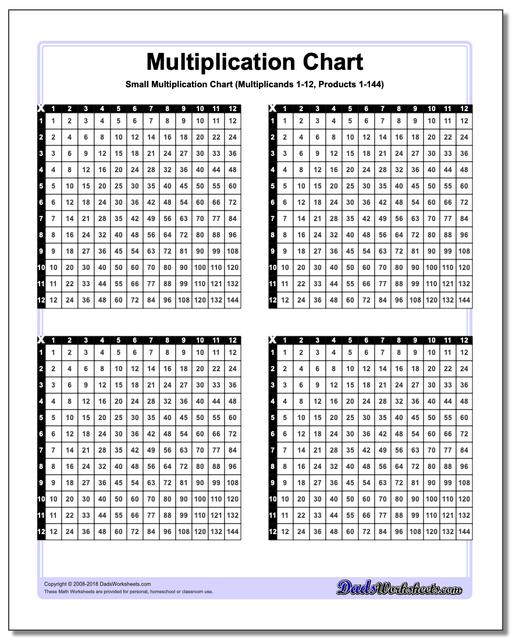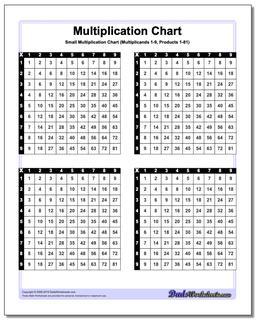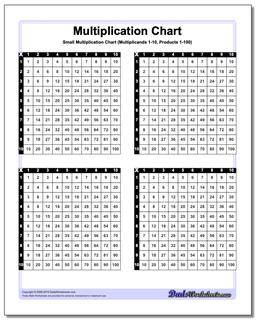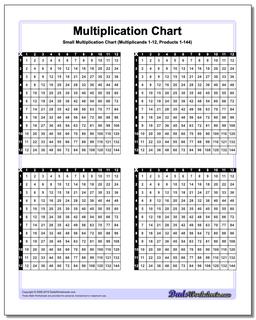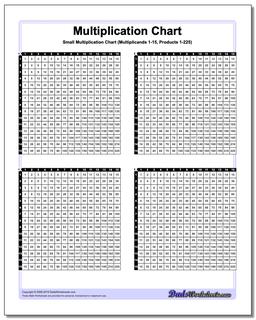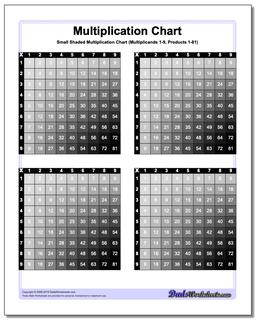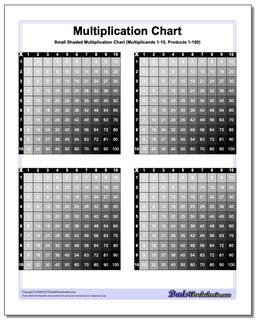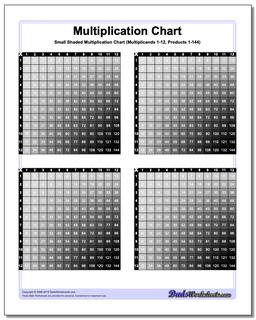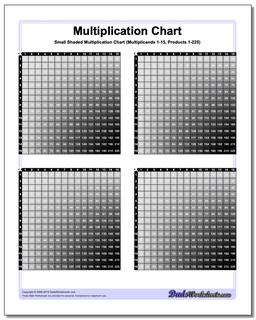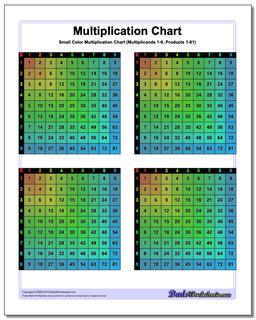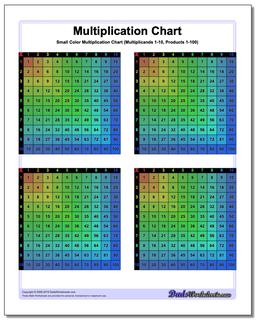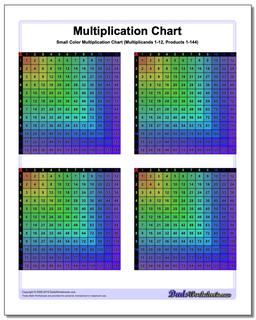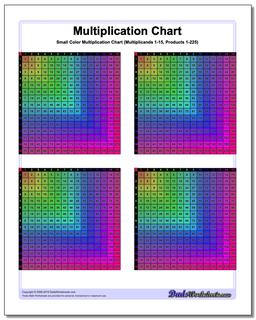Core Math Worksheets
Fraction Worksheets
Word Problems
Algebra and Trigonometry
Other Worksheets
Place Value
Percentages
Rounding Numbers
Ordering Numbers
Standard, Expanded, Word Form
Mean Median Mode Range
Ratio Worksheets
Probability Worksheets
Roman Numerals
Factorization, GCD, LCM
Prime and Composite Numbers
Pre-Algebra
Geometry Worksheets
Blank Clocks
Telling Analog Time
Analog Elapsed Time
Greater Than and Less Than
Money
Arithmetic Sequences
Geometric Sequences
Venn Diagram
Graph Worksheets
Measurement & Conversions
Patterns and Puzzles
Color by Number
Holiday & Seasonal
Early Learning
Printables
Calculators
Multiplication Chart: Small Multiplication Chart
Do you need a small printable multiplication table you can put in your pocket, tape to student desks or laminate and hand out at parties? You MIGHT be a math teacher! Any place you need multiplication in a flash, these charts will be there for you! These multiplication tables appear small on the screen, but they are vector images designed to be printable at high resolution and will be razor sharp on your printer.
Small Multiplication Chart
Small Shaded Multiplication Chart
Small Color Multiplication Chart
Printable Small Multiplication Chart
Print these out, cut them up and then share them with your friends or students. Sometimes a full-size multiplication chart is more multiplying than you need, and these smaller versions are perfect for less formal occasions. Multiplicands from 1-81, 1-100, 1-144 and 1-225 are all included in various styles.
Advantages of Having a Pocket Size Multiplication Chart
Just like any other types of charts, a small multiplication chart has its own adantages over the others, especially in certain contexts. The primary reason is that because of it having a small size, it allows for quick access without taking up much space and therefore more practical to use during math practice, exercises, and tests. Pocket-sized multiplication charts are also cheaper to produce and distribute, making them a cost-effective resource for schools and educational programs.
Uses of Small Multiplication Charts
How can you ultilize the effectivity of a pocket sized multiplication chart in various settings? Placing them in strategic locations helps ensure that they are accessible and utilized effectively for learning and reference. They can be easily carried in notebooks, homework folders, or even on students’ desks to name a few. Here are some of my other suggestions:
- Place laminated charts on or near student desks to provide a quick reference during independent work or tests.
- Include a small chart in homework folders or notebooks to assist students while they work on math assignments at home.
- For students studying at home, place a chart in their study area or workspace to provide immediate access to multiplication facts.
- Incorporate charts into math kits or educational toolkits used by teachers and students for various math activities.
- Use small pocket charts or posters that can be easily moved and adjusted for different activities or areas of focus.
- Send charts home with students for parents to use as a reference and to support their child's learning outside of school.
- Students can keep a small chart in their personal planners or binders for quick reference during study sessions or homework time.
Small Multiplication Charts and Other Math Tools
Small multiplication charts are handy tools for reinforcing multiplication skills and can be used effectively alongside other learning aids like flashcards and games in various ways. Continue reading below to see how it can complement these other math tools…
Use small multiplication charts as a reference while working with flash cards. Create or use printable flash cards with problems that correspond to entries on the chart. Quiz students on specific multiplication facts, and have them check their answers against the chart to verify their responses. After using flash cards to test their knowledge, students can use the chart to reinforce and review the facts they found challenging.
Integrate small multiplication charts into board games where players might need to check multiplication facts to move forward or win. For example, you can create a board game where players roll dice and use the chart to find the product of the dice rolls. You can also use the charts in quiz-style games where students have to answer multiplication questions and use the chart to verify their answers or see if they were correct. Another example is to incorporate charts in timed challenge rounds where students quickly locate and solve multiplication problems to score points or complete tasks.
Set up math stations where students rotate through different activities. One station can feature the small multiplication chart as a reference tool for solving problems at other stations. You may also combine physical charts with hands-on activities like building multiplication fact families using manipulatives and then refer to the chart for verification.
For visual learners, using a small multiplication chart alongside manipulatives like number lines can significantly enhance students' understanding of multiplication by making abstract concepts more tangible. By using the small chart, students can quickly check their answers and see patterns. For example, if they use the number line to count by 5's, they can refer to the chart to see that 5 × 4 = 20, showing the concept that each jump on the number line corresponds to a product shown on the chart.
Use the small multiplication chart alongside worksheets that have blank multiplication grids. Students can fill in the charts based on their knowledge and then use the small chart to check their answers or fill in any gaps.
Use small charts during review sessions to quickly look up and practice multiplication facts that students are working on in other activities. In problem-solving activities, students can use charts to check their calculations and understand the relationship between numbers more clearly. They can also refer to the chart to check their answers or to see multiplication facts they may be unsure about.
After identifying multiplication facts that a student struggles with using flashcards or games, they can focus on those specific facts on the chart. Use the charts to track progress and improvement over time. Students can mark off mastered facts or highlight areas that need more practice.
In group activities or math circles, small charts can be used as a shared resource to facilitate discussion and collaborative problem-solving. Students can also use the charts to help teach peers who might be struggling with certain multiplication facts, reinforcing their own understanding in the process.
Encourage students to use small multiplication charts as part of their homework routine to reinforce what they’ve learned through flashcards and games. Additionally, providing charts to parents to use alongside educational games and flashcards at home will facilitate support and practice outside the classroom.
These are not the Multiplication Charts you are looking for?
Click to check out the main multiplication chart page... You'll find dozens of other options including cool themed multiplication charts, multiplication charts with larger ranges of products and much more…
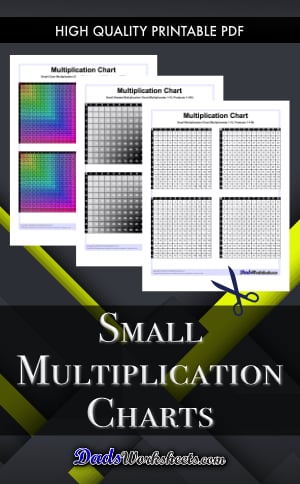
Worksheet History
